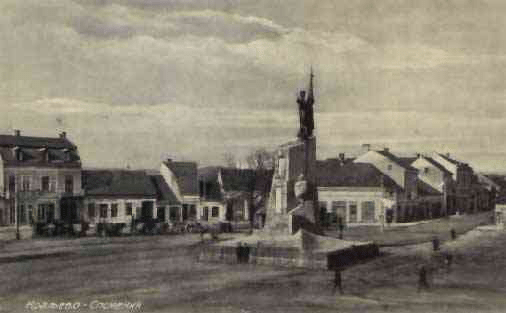
History of the city of Kraljevo is most concisely seen through the changes of the name of the place. The first mention of the settlement under the name of Rudo Polje is found in 1476. Somewhat later, around 1540, dual name was in use – Rudopolje and Karanovac. On the occasion of a visit of the King Milan Obrenovic to Karanovac, and on request of the citizens, the name was changed into Kraljevo on 19 April 1882. In a short period (1949 -1955) the name of Rankovicevo was in use just to reestablish the name of Kraljevo afterwards.
Space around the lower course of the River Ibar and itc confluence into the West Morava, has been a human settlement since anscient times. This is inferred by archeological sites in Ratina, Kovanluk and Konarevo, as well as many individual findings.
Ancient Rome and Byzantium also left traces on this area. Janok, Rajanovac and Vrnjacka Spa in the neighborhood date since then. The oldest mention of a place of Kraljevo area can be found in Byzantine sources from the 10th century mentioning densely settled Janok, which was probably located south-west of Kraljevo, in the area of today’s Konarevo.
These areas have been within the Serbian state since its creation and they play an important role in the economic, social and political life, but above all, here was the spiritual center of the young Serbian state. At the end of the 12th century the Monastery of Studenica, memorial of the Grand Zupan Stefan Nemanja, founder of the independent Serbian state and the Nemanjic Dynasty, was built. At the beginning of the 13th century the Monastery of Zica, memorial of Stefan the First-Crowned was built , where in 1217 he was crowned the first Serbian king. In 1219, the Monastery of Zica became headquarters of the Autocephalous Serbian Church and the first Serbian Archbishop Staint Sava. The fortified town of Maglic, raised on an important strartegic spot, is also from the 13th century.
In the half of the 15th century, Osmanic (Turkish) occupation begins and doesn’t end up until the beginning of the 19th century.
We can say that Karanovac didn’t become significant settlement until 1718, after the signing of the Pozarevc Peace Treaty and establishment of the Austrian-Turkish border along the West Morava.
Turkish occupation ended in the beginning of the 19th century with the First and the Second Uprising. What follows is development of Karanovac conditioned, above all, with geographic position, trade, craftwork and newly acquired administrative role. During the 19th century, it grows into a significant town center of Serbia. With the construction of the church in 1824, a new direction and space for the town development г – space between the Old Downtown and Pljakin Sanac, was determined. The first urbanistic plan of Karanovac was done by Laza Zuban in 1832. Realization of the plan commenced in 1836 when ‘three main streets’ were formed in the town. Until the 19th century, cutting new alleys, a network of streets was created with still maintained feature of regular intersection starting from the central round sqaure in four directions.
Development of the town was followed by the increase of the number of citizens. In 1846, there were 1022, and in 1921, 3570 citizens.
After the First World War, thanks to investments of the state and foreign capital, a new phase of development with distinct industrialzation begins in Kraljevo. In 1922, a rail workshop was built, which later grew into a wagon factory. The Aircraft Factory was started in 1926 and completed in 1928 when first aircrafts were manufactured in cooperation with the French company Brege. Consequence of such rapid development was sigificant increase in the number of citizens. Therefore, in 1931, there were 7022.
Development of the town and the surrounding area was stopped with German occupation from 1941 until 1944. Massive execution of hostages happened in October 1941 in Kraljevo when one hundred Serbs were executed for one killed German soldier, and fifity for one injured. Industrial companies and citizens’ property were destroyed with depredations and robberies.
After the Second World War, Kraljevo experienced intense economic, cultural and urbanistic development. Skeleton of the economy were the Wagon Factory, Refracted Materials Industry ‘Magnohrom’, Wood Combine ‘Jasen’, Technical Gases Factory ‘Goc’ and series of agricultural, traffic, ore mining and craft companes.
Today, Kraljevo is significant cultural, educational and tourist center.
Elementary school has existed since the end of the 18th century. Agricultural School, the first secondary school, was opened in 1882. In the beginning of the 20th century, the trading school and the gymnasium were opened. In the Thirties, professional secondary schools were also opened, which there were more and various after the Second World War. In 1970, the Center for extramural mechanical studies, which later grew into the Faculty of Mechanical Engineering within the University of Kragujevac, was opened in Kraljevo.
